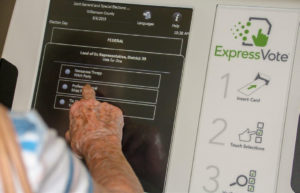 Tribune News Service
Tribune News ServiceAs the 2019 general elections for Greene County are rapidly approaching, the voter registration deadline has passed.
Tina Kiger, Greene County elections director, broke down the numbers for Greene County’s voter registration pool and how important it is for registered voters to perform their civic duty.
“We need more voters to actually go to their respective polling place and cast their ballots,” Kiger said. “There are people who believe that their ‘one vote’ will not count, but actually, when all of those ‘one votes’ are counted and totaled, the results could definitely make a difference.”
Kiger said there have been elections in the past that depended on just one vote.
Breaking down the numbers, Kiger said there are 21,418 registered voters in Greene County as of Oct. 10. Putting that in comparison with the total county population of an estimated 36,850 people, then around 60% of Greene County citizens are able to vote on Nov. 5. Kiger also explained how less than half of those registered voters typically show up to vote at any local election. This means it is estimated that there is less than 30% of Greene County citizens voting at the polls each election day.
“There are a lot of voters who will only vote during the Presidential Election, which is very important,” Kiger said. “However, every election is important, whether it is a Federal, State or Local Election. The people who we as voters put into office are making decisions about our infrastructure.”
In the last 4-5 years, Kiger said there has been an increase in voters registering as republican and switching their party to republican. Out of all registered voters in the county, there are 10,603 registered democratic voters, and 8,714 registered republican voters, making the Democratic Party the county majority by registration alone.
On the technical side of the local elections, electronic voting system custodian Scott Kelley emphasizes the role of digital voting machines in the upcoming election. In recent elections around America, there has been public concern for the accuracy and legitimacy of digital voting machines and whether or not they are reliable and consistent.
“Nothing is foolproof – but we come as close to fool-proof as we possibly can. First, each system is tested and accepted by the Federal EAC. Then, it is tested and accepted by the State Bureau of Elections,” Kelley said. “Here at the county, we are fully trained on the system, and we have experience and knowledge of working with electronic systems back to 1999 when the county got its first system.”
Kelley also explained how rovers are used to help set up and support the machines on election day. Rovers are usually unbiased county employees with a basic IT background and have “close to zero” political activity in real life and on social media.
“In 20 years – 40 elections – I have been pulled into court once on a challenge of the system,” Kelley said. “While that turned into a bit of a show-and-tell, with the documentation we had, we were able to tell the court exactly how many votes was on each machine prior to it being unsealed, exactly what equipment was used in the precinct in question and exactly what the vote counts on each machine were.”
The series of tests and prep ensures the electronic voting machines perform to the best of their abilities and are as accurate and functional as possible.
Election Day is on Tuesday, Nov. 5, and is the day all registered voters across the nation can perform their democratic and civic right at their local polling center.
“[One quote] that I love,” Kiger said, “‘Nobody will ever deprive the American people of the right to vote except the American people themselves … and the only way they could do this is by not voting,’ [said] Franklin D. Roosevelt.”
